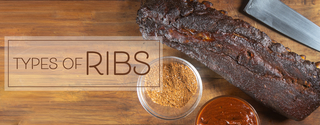Types of Ribs

Types of Ribs
When we think of ribs, we think about tender, smoky meat rubbed with flavorful seasonings and cooked until it has a crisp bark or falls off the bone. Barbecue staples like spareribs and baby back ribs are pork cuts, while soothing comfort cuts like short ribs come from beef.
Pork ribs are generally easy to eat and are great for a crowd, thanks to their manageable size. Beef ribs tend to be much larger than pork ribs; a single pork sparerib, the largest of the pork ribs, weighs about 6 ounces, while an individual beef short rib can weigh more than one pound.
Both beef and pork rib cuts have fat and connective tissue running through the meat, which all need to cook down under gentle heat for the best results. These cuts of meat are almost all suitable for smoking or low-and-slow barbecuing. If using a grill or smoker is not possible, ribs can be roasted in the oven at a slow-cooking, low temperature. Some beef cuts work well in a braise.
Types of Pork Ribs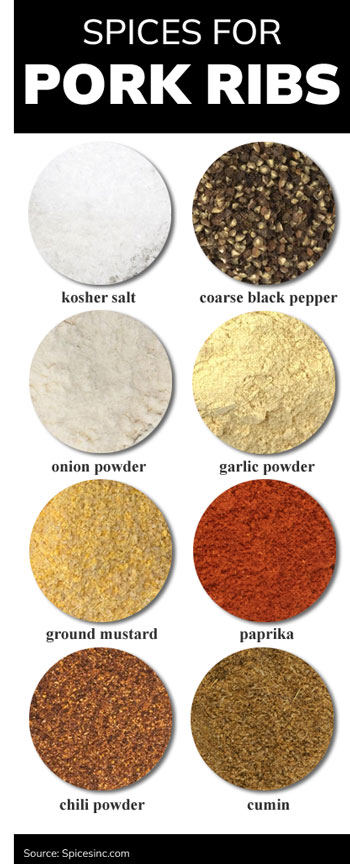
Baby back, sparerib, and St. Louis cut are the most popular of the different types of pork ribs. Pork goes well with a wide range of flavors and seasonings because it is sweet and mild. This makes cooking with pork fun because its mild nature allows you to hone in on the flavors you like so that you can create your own signature rib seasoning with confidence and a little experimentation.
No matter which type of rack you choose, remember to look for meat that is deep pink, leaning toward red. The meat should be evenly distributed through the rib meat, with even striations of fat rather than fatty pockets.
If you can see the rib bones clearly, choose another rack. This is called a “shiner,” meaning the meat has been cut too close to the bone and will likely fall off instead of cooking correctly.
Avoid ribs that have been altered. Don’t choose ribs that have been frozen or ones that have been “enhanced” with a sodium solution to plump up the meat. That information should be readily available on the label. When you make ribs, you want to be able to taste the meat coated with a spicy rib rub and a sweet, tangy barbecue sauce, not a solution of saline and water.
Pork ribs extend from the spine to the belly, so we’re going to start with the spine and work our way down.
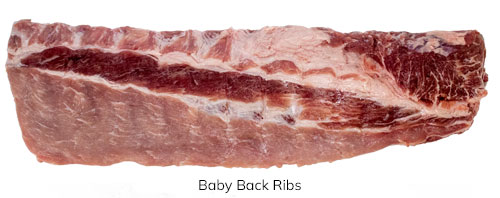
Baby Back Ribs
Baby backs are cut from the small section of pork ribs that curve beneath the lean pork tenderloin that runs along a pig’s spine. Baby backs are the portion that attaches to the backbone, which you may hear referred to as the “chine”. The name “baby back” refers to the relative smallness of the rib section from which the ribs are cut and has nothing to do with the age or size of the animal.
The meat on baby backs tends to be leaner than spareribs and St. Louis cut ribs, which come from the area around the fatty belly. Baby back ribs are somewhat curved; they are cut from the backbone and then cut from the lower portion of the ribs where the bones’ natural curve flattens. This leaves baby backs looking a little bit like the rounded blade of a hockey stick.
Baby back ribs are best cooked over low, indirect heat. Baby backs are some of the best type of ribs to smoke, but they can also be barbecued or roasted in the oven. As mentioned before, they are a bit leaner than other pork ribs. In terms of cooking time, they don’t have to cook quite as long or as low as other ribs.
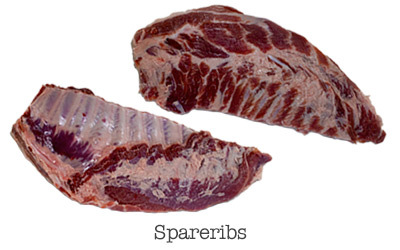
Pork Spareribs
Spareribs come from the lower portion of the rib cage once the baby backs have been cut off. The whole sparerib extends from the cut made by the baby back removal to the meaty rib tip.
The trimming for a rack of spareribs is kept to a minimum. Large chunks of fat are removed, and a thin, dangling bit of meat on the back side of the rib called the skirt is usually cut off, but the sparerib stays intact. Meat on a sparerib is fatty since it attaches at the bottom to the belly, which is where bacon comes from. Spareribs are crossed with connective tissue and fat, requiring attention and time to become tender.
People often choose the 3-2-1 cooking method when making spareribs since it ensures a low temperature and plenty of cooking time, allowing connective tissue to break down and make tender ribs. They also do well baked in an oven set at a low temperature for several hours.
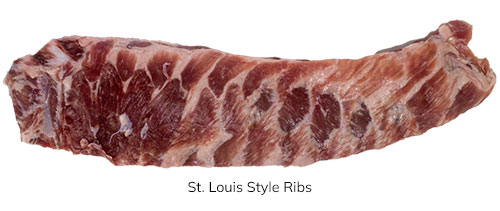
St. Louis Style Ribs
The St. Louis Cut is taken from the spareribs. The rack of ribs is trimmed into a tidy rectangle. First, the breastbone is cut off along the top of the spareribs. The breastbone’s texture is unpredictable; it might be smooth, or it can have chunks of cartilage that are difficult to eat.
The tips on the bottom of the rib and a small, triangular piece of boneless meat called the flap also come off since they tend to cook at a different rate than the bone-in ribs. The flap on the back of the ribs, called the skirt, also comes off.
This results in a rack of ribs that is neat and almost symmetrical, with similarly-sized bones. The uniform shape means a rack of St. Louis-style ribs cooks evenly. This is often the choice cut for restaurant ribs because their uniformity is easy for a kitchen to manage. You can make these ribs successfully with any cooking method, but we love St. Louis ribs smoked to perfection.
While we have a St. Louis Rib Rub that’s perfect for this cut, you can try almost any of our pork-friendly seasoning blends on any rack of pork ribs. Look for a mix that combines sweet and spicy components and relies more on spices than herbs because herbs are more likely to burn. Or use our favorite pork spices to create your rib blend.
Types of Beef Ribs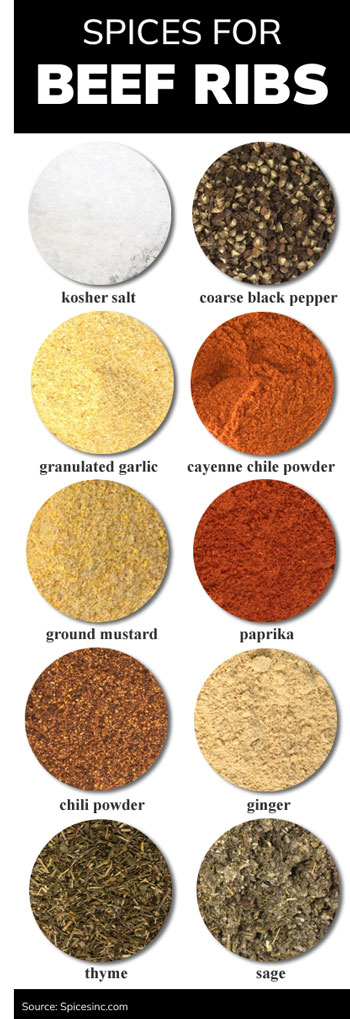
There are three significant cuts of beef ribs: short ribs, chuck short ribs, and beef back ribs, and they all come from different parts of a steer. A fourth cut, flanken ribs, is a product of how a grouping of ribs are cut and doesn’t indicate the part of a cow the ribs come from.
Cattle have 13 pairs of ribs, going from its shoulders to halfway down the spine. Ribs 1-5 start under the shoulder, while 6-13 are the ribs along the midsection. Rib 13 is part of the loin cut, not a rib cut. The anatomical source of each kind of rib impacts the way the meat tastes and feels and also influences the ways to cook it.
Like pork ribs, beef ribs have a lot of fat running through the meat. To make great beef ribs, prepare them properly so the fat can render into the meal and create terrific flavor and tender meat. Because of beef’s hearty nature, it does best with aggressive, warm spices and seasonings that won’t get lost against the bold flavor of beef.
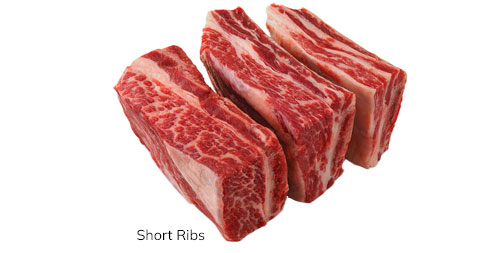
Short Ribs
A traditional short rib comes from the lower portion of the ribs that extend toward a steer’s belly and incorporates ribs 6-12. These are the meatiest ribs you’ll find. They’re traditionally taken from the steer in a flat, neat cut called a plate.
Short ribs are cut parallel to the bone and are generally between 3-6 inches long and 3-5 inches thick. One rib can weigh more than a pound. The meat has a robust mix of muscle, tendons, and fat, delivering tons of flavor. They are usually trimmed before they are sold, so additional trimming before cooking is unnecessary.
Ribs 1-5, which nestle under the shoulder of the steer, are increasingly cut into short ribs. The shoulder is a hard-working area of the steer, so it produces meat that’s muscular and rich with connective tissue and fat. Ribs from the chuck area have a similar flavor and texture and work with the same cooking methods as standard short ribs.
The best way to cook short ribs is with low and slow heat to give fat ample time to break down. They are luscious when cooked in a smoker, turn silky in a braise, and are succulent with a gentle oven-roasting. They come from the area right next to the brisket, so a blend like Beef Brisket Rub would work well with this meat.
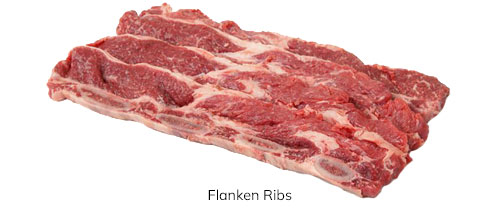
Flanken Ribs
Flanken ribs are a specific way to cut ribs rather than a rib taken from a particular section of cattle. This cut is made from a row or plate of still-connected short ribs either from the plate or the chuck, cut between ¼ and ½ inch thick across the bone. When you look at a slice of flanken rib, you’ll see three or four cross-sections of bone in the rib meat.
Because flanken ribs are open to several wildly different cooking methods, you are welcome to trim them if the fat cap seems too thick. Trimming usually depends on your cooking method; the fat on them can be hard, so if the cooking time is short, then consider giving the meat a trim so you don’t have to chew through hard, gristly fat.
The most well-known way to use flanken ribs is in kalbi or galbi, the Korean short rib dish that’s gaining popularity across the US. To make kalbi, marinate flanken ribs for up to four hours in an aromatic sweet and sour sauce like Korean Barbecue Sauce—thin it out to use as a marinade, and make more as a topping when the ribs are done. Grill them for 3-4 minutes per side. They can also be oven roasted at a low temperature for two hours, flipping once. If you choose to oven-roast them, trimming the fat is unnecessary.
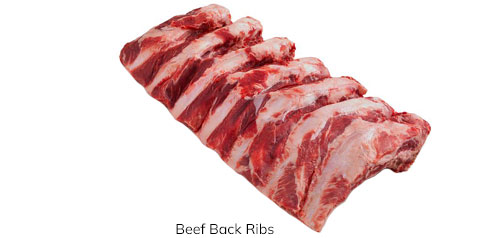
Beef Back Ribs
Beef back ribs are taken from ribs 6-12. They are about 8 inches long and come from the curved portion of the steer's ribs that adjoin with the spine. Back ribs come from the same section that produces Ribeye Steak, Tomahawk Steak, and rib roast.
Back ribs don’t carry as much meat on them as other beef ribs, so they don’t take quite as long to cook and are open to a wide range of cooking styles. They can be grilled, braised, or smoked. Please make sure you use indirect heat when you cook them to prevent scorching.
They may have a membrane across the back of the ribs. There is tremendous debate about whether to remove it or not. If you plan to use a knife and fork to eat these ribs, you can cut away the membrane at the table during your meal. If you plan to eat these in hand, with no fork, then we think you should peel the membrane off before cooking since it can be difficult to chew through.
The meat from this area is juicy and rich, but it’s often taken for these other cuts of meat. Season beef ribs with your favorite steak seasonings; they do well with bold, strapping flavors like mustard, cumin, or cayenne.
With a few exceptions, the general rule of rib cookery is to cook them slowly, over low heat. They need time for the gelatinous fats and tissues to cook into the dish, releasing their flavor and creating tender meat. Pork ribs can often be cooked with interchangeable seasonings; what is good for baby backs is also suitable for spareribs. Beef ribs require a little more thought and specialization because the meats come from different parts of the cow and enjoy multiple, creative cuts.

